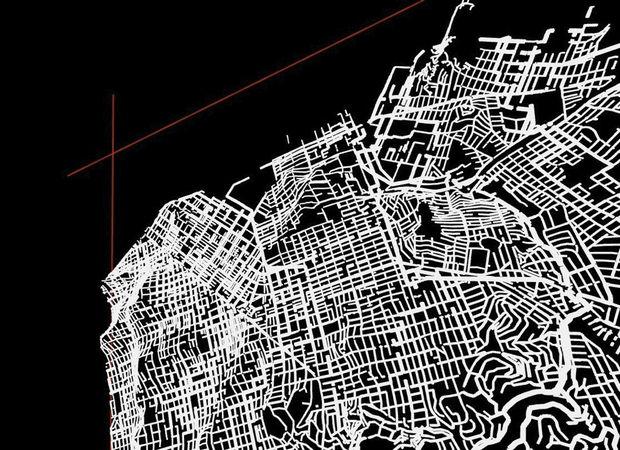 The city of San Francisco is known for many things–its steep hills, its exquisite view of the bay, its landmark Golden Gate Bridge, its trolley cars, its rich, lively culture. Of far less interest is its sewer system. One of those necessary aspects of urban life, the complex sewer system of San Francisco and the larger water infrastructure of the city itself, captured the attention of Scott Kildall, an artist of exceptional technical savvy, who, according to his Instructables bio., “indulges in network performances and creative coding.”
The city of San Francisco is known for many things–its steep hills, its exquisite view of the bay, its landmark Golden Gate Bridge, its trolley cars, its rich, lively culture. Of far less interest is its sewer system. One of those necessary aspects of urban life, the complex sewer system of San Francisco and the larger water infrastructure of the city itself, captured the attention of Scott Kildall, an artist of exceptional technical savvy, who, according to his Instructables bio., “indulges in network performances and creative coding.”
Kildall, who is currently an artist-in-residence at software corporation Autodesk, conceived of what he has titled his “Water Works” project. According to Kildall, “Water Works is a data-visualization and mapping of the San Francisco water infrastructure: the pipes, hydrants and treatment plants that comprise the circulatory network for [the] city.” The project, explained Kildall, is “part of a larger Creative Code Fellowship, supported by Gray Area, Stamen Design and Autodesk.”
Most recently, Kildall’s Water Works project has taken on the San Francisco sewers and his Instructables post provides details of the process for “creating a 3D printed artwork based on  sewer data of San Francisco.” For the sewer project, the artist enlisted the Department of Public Works in San Francisco, which oversees the engineering for the city’s sewer system. The DPW shared with Kildall a dataset of the pipe connections and sewer node for the entire city. “The data,” explained Kildall, “consists of many, many fields but the important ones are the manholes (nodes) and the pipes that connect them. The nodes are geolocated, which means that I can map it out as X, Y values in the 3D space. And each pipe indicates an upstream and downstream node, so there are connections between the different nodes.”
sewer data of San Francisco.” For the sewer project, the artist enlisted the Department of Public Works in San Francisco, which oversees the engineering for the city’s sewer system. The DPW shared with Kildall a dataset of the pipe connections and sewer node for the entire city. “The data,” explained Kildall, “consists of many, many fields but the important ones are the manholes (nodes) and the pipes that connect them. The nodes are geolocated, which means that I can map it out as X, Y values in the 3D space. And each pipe indicates an upstream and downstream node, so there are connections between the different nodes.”
Kildall took the dataset and, perhaps appropriately, cleaned it, dispensing with irrelevant data. He then generated two separate CSV files with the node and the pipe data to be imported to OpenFrameworks, an open source toolkit for creative coding. Using OpenFrameworks, he generated a 3D rendering of the San Francisco sewers. At that point, the artist felt he had achieved an early level of success, reporting, “What made me happy was seeing the San Francisco terrain reflected in the node and pipe data.”
Next, Kildall converted the basic cubes representing the nodes to rounded-edge cubes that seemed to him more reflective of the shape of manhole chambers; these connected with the pipe system in his 3D rendering. After creating two STL files of the nodes and pipes, the diligent tech-artist double-checked his work in MeshLab to “verify that the geometry [was] correct.”
Before printing the final version of the sewer system, Kildall produced a number of test prints for structural testing and for color. The test prints were made, according to Kildall, “at the Pier 9 facility, using the Objet 500 printers. These let you print in multiple materials and I made various grayscales by blending VeroBlack and VeroWhite resin. The final printing took around 40 hours and, Kildall notes, “took a lot of material.” Since the final print was very sturdy, Kildall used high-pressure water and dental tools to clean it up. The final, non-aromatic sewer system model was mounted on a wooden based, which Kildall had etched with a map of the city.
What do you think about this interesting use of 3D printing? Would you believe how complicated this sewer system was without seeing this print? Discuss in the 3D printed San Francisco Sewer forum thread on 3DPB.com.
[Image Source: Gray Area Foundation]Subscribe to Our Email Newsletter
Stay up-to-date on all the latest news from the 3D printing industry and receive information and offers from third party vendors.
Print Services
Upload your 3D Models and get them printed quickly and efficiently.
You May Also Like
Making Space: Stratasys Global Director of Aerospace & Defense Conrad Smith Discusses the Space Supply Chain Council
Of all the many verticals that have been significant additive manufacturing (AM) adopters, few have been more deeply influenced by the incorporation of AM into their workflows than the space...
EOS in India: AM’s Rising Star
EOS is doubling down on India. With a growing base of aerospace startups, new government policies, and a massive engineering workforce, India is quickly becoming one of the most important...
PostProcess CEO on Why the “Dirty Little Secret” of 3D Printing Can’t Be Ignored Anymore
If you’ve ever peeked behind the scenes of a 3D printing lab, you might have caught a glimpse of the post-processing room; maybe it’s messy, maybe hidden behind a mysterious...
Stratasys & Automation Intelligence Open North American Tooling Center in Flint
Stratasys has opened the North American Stratasys Tooling Center (NASTC) in Flint, Michigan, together with automation integrator and software firm Automation Intelligence. Stratasys wants the new center to help reduce...





































